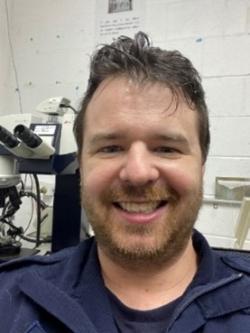PhD candidates

Ali Almazrouei
Evaluating Source Conclusions and Criteria in Toolmark Examinations: Enhancing Decision-Making Practices in Firearms Identification
Supervisors: Distinguished Professor Claude Roux , Associate Professor Scott Chadwick and Dr Mackenzie de la Hunty
Expected completion date: July, 2027
My project aims to enhance the reliability of forensic firearms identification by critically evaluating and improving the criteria and decision-making processes used by toolmark experts. The research will begin by establishing a comprehensive overview of current scientific practices regarding source conclusions and evaluation criteria in toolmark examinations. By exploring and critically assessing how experts form these conclusions, the project seeks to gain foundational insights into their decision-making processes. Ultimately, it will provide critical findings and offer practical recommendations to refine the criteria and methodologies used in toolmark examinations, contributing to more accurate and dependable forensic analyses in firearms identification.

Analisa Chiaravalle
Investigation of Metal-organic Frameworks in Gunshot Residue
Supervisors: Associate Professor Scott Chadwick, Associate Professor Alison Beavis, and Distinguished Professor Claude Roux
This research aims to firstly synthesise, characterise and evaluate the stability of a range of novel metal-organic frameworks (MOFs) for incorporation into ammunition, and secondly to determine whether the addition of MOFs into ammunition affects gunshot residue (GSR) distribution, bullet accuracy or firearm mechanisms. Incorporating MOFs into ammunition will allow investigators to visualise luminescent GSR, which can generate a link between a person of interest, firearm or crime scene. The ability to visualise GSR particles will also aid investigators by streamlining the collection process at a scene to avoid long sample queues in the laboratory.

Anillada Nettakul
Optimizing ancestry inference through efficient extraction and preservation of DNA from bone
Supervisors: Professor Dennis McNevin, Dr Maiken Ueland
Expected completion date: June 2028
This research project focuses on enhancing ancestry inference by optimising a DNA extraction method for bone samples. The innovative approach from this research utilizes preservative solutions to leach DNA from bones, simplifying the extraction process and reducing the risk of DNA damage. The primary aim is to genotype Ancestry Informative Markers (AIMs) from DNA extracted using preservative solutions, providing a more efficient and reliable approach to ancestry inference. This innovative method has the potential to enhance human identification in forensic investigations, providing forensic scientists with a valuable alternative for ancestry prediction from challenging biological samples.

Archie Lambrinos
Development of chemical sensing techniques for in-field drugs of abuse testing
Supervisors: Professor Shanlin Fu and Dr Morgan Alonzo
Expected completion: July, 2026
Well established presumptive chemical colour tests exist for the traditional drugs of abuse such as heroin and methylamphetamine commonly found at crime scenes. However, there are very limited ones for the newly emerged new synthetic drugs including piperazines, cathinones, NBOMEs and fentanyls. The aim of this project is to develop sensitive and specific drug test methods for in-field testing of these new synthetic drugs. The study will also investigate the feasibility of developing a multiplexer that can screen these different drug classes simultaneously in a single test. Availability of these new test methods will help increase the in-field drug testing capability and efficiency for the law enforcement authorities.

Ayusha Dahal
A multidisciplinary approach for the forensic examination of skulls
Supervisors: Associate Professor Jodie Ward, Professor Dennis McNevin, Dr Denise Donlon, and Professor Stewart Fallon
This research aims to review the accuracy of the age at death, sex, and ancestry estimations from different forensic examination approaches by comparing the results against known and self-reported donor data.
The findings of this research will contribute to development of a recommended multidisciplinary approach for forensic human identification in skull only cases.

Bridget Thurn
Investigating methods of detecting victims in mass disasters
Supervisors: Dr Maiken Ueland and Dr Steven Su
Expected completion: June, 2025
Current methods of detecting victims in disaster areas are unreliable and can be dangerous to human and canine search teams. This project aims to investigate alternative methods to locate victims, and does so by utilising the volatile organic compounds (VOCs) that comprise odour. By sampling the VOCs released from living and deceased individuals, ante- and post-mortem odour profiles will be developed and used to inform new technologies such as electronic noses that will aid future search-and-rescue efforts.

ChaeRin Hayley Song
Forensic Intelligence in the Cultural Aspect of Handwriting Examination and to Improve the Effectiveness of Forensic Handwriting Examination
Supervisors: Distinguished Professor Claude Roux, Dr Marie Morelato, Professor James Brown
Expected completion date: July 2027
I'm currently working on analysing English handwriting of different cultural backgrounds. From these extracted features, I'll be working statistically and to develop an automatic machine learning program that could assist handwriting examination field by combining forensic intelligence.

Ciara Devlin
The potential of using the forensic profiles of fraudulent identity documents to assist in intelligence-led policing
Supervisors: Dr Marie Morelato, Associate Professor Scott Chadwick, Dr Sebastien Moret, Dr Simon Baechler, and Dr Jennifer Raymond
Expected completion: December, 2024
Currently there is little understanding of the fraudulent document climate here in Australia. My project aims to gain an understanding of this marketplace through examining the manufacture and distribution of fraudulent identity documents in Australia. By profiling the visual characteristics of these documents it is possible to identify those that have been produced by the same source. We are investigating whether a systematic method for profiling and comparison of these fraudulent documents could be implemented within Australia, assisting in the identification of prolific offenders, organised crime groups and terrorist cells.

Ciara Di Scala
Algorithms for forensic kinship analysis
Supervisors: Professor Dennis McNevin, Dr Jodie Ward, Dr Kelly Grisedale
Expected completion date: July 2027
This project aims to develop algorithms capable of comparing and analysing autosomal, sex chromosome and mitochondrial SNPs to extract information about sample donors such as their biological sex, ancestral origins and genetic relationships. These algorithms could be used to compare SNP profiles of persons of interest to aid in generating leads and linking cases, especially in relation to unidentified human remains and long-term missing persons. Such a program could be used in forensic laboratories where SNP genotyping is performed in-house and where a dedicated analysis pipeline is required and would be of use to the National DNA Program for Unidentified and Missing Persons.

Eathan Walker
Metabolic biotransformation of Synthetic Cannabinoid Receptor Agonists (SCRAs)
Supervisors: Professor Shanlin Fu, Dr Morgan Alonzo and Dr Unnikrishnan Kuzhiumparambil
Expected completion: February, 2027
Synthetic Cannabinoid Receptor Agonists (SCRAs) are an ever-evolving subclass of drugs belonging to the New Psychoactive Substances. This project aims to use an in-vitro model in which human liver microsomes are utilised to produce phase 1 metabolites for various SCRAs identified using LC-QToF-MS. Identifying these metabolites assists with extrapolating the involved metabolic pathways and biotransformations for each SCRA investigated. This allows for specific metabolites to be proposed as biomarkers that can indicate the presence of the parent SCRA within a human system.

Emily Sunnucks
A novel multi-omics approach to estimating time since death
Supervisors: Dr Maiken Ueland, Associate Professor Matt Padula, Dr Lana Brockbals, Professor Dennis McNevin
Expected completion date: August 2027
Time since death (TSD) estimation remains one of the most challenging issues for investigators during forensic death investigations due to the complexity of decomposition chemistry. This project aims to create an objective and accurate approach for TSD estimation. Muscle and VOC samples collected at various time points post-mortem will be analysed using a suite of mass spectrometry-based analytical instrumentation to develop a model combining four-omics techniques: lipidomics, proteomics, metabolomics and volatilomics. This multi-omic technique allows coverage of a wide range of biomolecule degradation, leading to a more comprehensive understanding of the complex chemical and biological changes behind decomposition.

Harrison Fursman
Expanding Our Understanding of Injecting Drug Consumption: Chemical Analysis Before and After Injection
Supervisors: Dr Marie Morelato, Distinguished Professor Claude Roux and A/Prof Scott Chadwick
Expected completion: October 2026
This research aims to gain a better understanding of consumption trends among people who inject drugs, utilising two innovative methods of monitoring. The first method involves a spatiotemporal analysis of used syringes collected across Sydney in order to analyse their residual drug content. The second method involves the optimisation and implementation of a portable near-infrared technology for the characterisation of illicit drugs for use in policing and health contexts.

Harrison Woodward
Investigation of the surface composition and texture of plastic substrates for fingermark development
Supervisors: Dr Sebastien Moret and Associate Professor Scott Chadwick
Expected completion: April, 2025
This project aims to thoroughly explore the surface morphology and composition of a wide range of polymers to determine the influence on fingermark detection methods. With further understanding of these factors, more effective and targeted methods may be able to be employed operationally, leading to higher success rates of fingermark detection.

Helen Roebuck
DNA transfer at crime scenes - an investigation into prevalence of non-donor DNA
Supervisors: Associate Professor Georgina Meakin, Professor Dennis McNevin, and Roland van Oorschot
Expected completion: July, 2030
From a systematic review and meta-analysis of published data, this project will aim to investigate the variables impact the transfer of non-donor DNA to handled items. From experimental laboratory based studies data will be further generated to inform the circumstances under which non-donor DNA can be deposited onto items when handled by an 'offender' in simulated crime scenes. Combined, these data will assist in guiding forensic practitioners in their interpretation and evaluation of trace DNA evidence recovered from crime scenes.

Jessica Watson
The identification of missing persons in Australia using emerging forensic genomics techniques
Supervisors: Associate Professor Jodie Ward, Professor Dennis McNevin
Expected completion: August, 2025
This research project is focusing on the implementation of emerging forensic genomic techniques to Australia’s unidentified and missing persons casework. It has been assisting
the Australian Federal Police National DNA Program for Unidentified and Missing Persons in
validating, optimising and implementing a suite of SNP capabilities for human remains casework
applications using medium-density SNP panels for the prediction of biological sex, biogeographical
ancestry, externally visible characteristics and forensic investigative genetic genealogy.

Joel Waszczuk
An evaluation of stamped firearm serial numbers, the interpretations of their chemically restored markings and photographic validations
Supervisors: Associate Professor Scott Chadwick, Dr Philip Maynard and Distinguished Professor Claude Roux
Expected completion: August, 2028
The project aims to assess the inconsistencies in stamped serial numbers, compare expert and novice interpretations of chemically restored markings, determining an error rate for interpretations and further assessing the suitability of validating results through photography.

Kainat Fatima
E-nose for Timber Products
Supervisors: Dr Maiken Ueland, Dr Shari Forbes (University of Windsor)
Expected completion date: January 2028
Illegally traded timber products hold a market worth approximately USD 152 billion pa. One of the main challenges is the rapid identification of timber species to determine if an item is legal or illegal. Current identification methods rely on visual identification or costly and destructive methods. The aim of the PhD project is to investigate the use of volatile organic compounds (VOCs) emitted from timber products as a means of identification. The project involves generating a database of VOC profiles from commonly illegally traded timber species using GC×GC-TOFMS to determine biomarkers of interest. These biomarkers will subsequently be used in development of an electronic nose for rapid, on-site timber species identification.

Kathy Tou
Lipidomics Investigations for Improved Equine Anti-Doping using LC-HRMS
Supervisor: Professor Shanlin Fu, Dr. Adam Cawley, Associate Professor David Bishop and Mr. Christopher Bowen
Historically when it came to the detection of drugs for anti-doping purposes, usually it is a targeted detection of the drug itself. However, there has been improvements into using biomarkers for an indirect form of screening to provide a complementary approach to current methods. My research aims to expand the current scope of biomarker detection using equine plasma to include lipids (specifically eicosanoids) and corticosteroids to detect for drug administrations used in the equine racing industry (i.e. exogenous corticosteroids and Bisphosphonates). This research will also aim to expand the biomarkers currently on the equine biological passport to provide a longitudinal assessment of individual horses and gain a better understanding of an individual horse compared to itself rather than the general population.

Layal Zaarour
The application of mass spectrometry-based proteomics for the identification of body fluids for forensic purposes
Supervisor: Professor Dennis McNevin, Associate Professor Matthew Padula and Dr Roland van Oorschot
Expected completion: April, 2025
This research focuses on the development of a mass spectrometry-based approach for the forensic identification of body fluids by targeting specific protein biomarkers present in biological fluids. This method aims to address the challenges of current tests and allow for the multiplex analysis of body fluids, where multiple analytes in one sample can be targeted simultaneously. The findings will also highlight what other information found within protein profiles of body fluids can be helpful to forensic investigations.

Lumikki Clover Ree
Investigation into the effect of surfactants in powder suspension formulations for fingermark development
Supervisors: Associate Professor Scott Chadwick, Dr Sebastien Moret, and Dr Mackenzie de la Hunty
This research aims to investigate the role surfactants play in the mechanism by which powder suspensions are able to develop fingermarks on various surfaces. Better understanding of this mechanisms will allow further optimisation of powder suspension formulations, which will improve the rate and quality of fingermark detection possible using this technique.

Lutfi Asad
Fingermarks in Blood: Protein Enhancement Methods and Interpretation
Supervisors: Distinguished Professor Claude Roux, Associate Professor Xanthe Spindler and Dr Sebastian Moret
Expected completion: August, 2025
This research project has 2 aims, with the first aim is to identify, develop, optimize and validate current proteins stains or novel optical instruments that are in use in other scientific fields that could enhance fingermarks in blood. The second aim is to identify, test and integrate methods to help interpret bloody fingermarks; e.g. was blood immersed onto a finger before being placed on a clean surface or did the surface contain blood before contact with the finger was made? With further understanding, we could reconstruct what took place in a crime scene and test different propositions.

Madysen Elbourne
Metabolomic analysis of equine urine for longitudinal assessments
Supervisors: Professor Shanlin Fu, Dr Adam Cawley and Dr Anjali Gupta
Expected completion: September, 2025
This research aims to expand the detection period of both allowed (route dependent) and prohibited therapeutic drugs in racehorses, using targeted and untargeted metabolomic analysis methods. The drugs of interest for this study are altrenogest, a steroid commonly used for hormone regulation in female horses, and Stavelo, a human anti-Parkinson's disease medication used to increase low levels of dopamine, however, is prohibited in the horse racing industry.
Manal Nasser M Alhosawi
Using mass spectrometry approach for toxicological investigation of functional neurological disorder (FND)
Supervisors: Professor Shanlin Fu and Dr Unnikrishnan Kuzhiumparambil, Dr Kasia Kozlowska and Dr Jinni Yan.
Expected completion: November, 2026
This study will identify metabolites that can differentiate patients with FND from controls, which will provide significant insight into molecular mechanisms and will lead to incorporation of promising biomarkers of FND into clinical practice.

Rachael Hoffmann
The utility of trace DNA for investigatons and intelligence purposes
Supervisors: Distinguished Professor Claude Roux, Dr Marie Morelato and Associate Professor Georgina Meakin
Expected completion: May, 2025
Using historical casework data to assess the utility of the information provided by trace DNA traces for criminal investigations and for intelligence purposes. Comparing this to the real-life application of these traces in investigations, to create a decision-making model considering recovery rates and the utility of trace DNA to assist in trace selection.

Rinika Barua
Biomarker Discovery of Functional Neurological Disorder in Children and Adolescents.
Supervisors: Professor Shanlin Fu, Dr Unnikrishnan Kuzhiumparambil, Dr Kasia Kozlowska and Dr Jinni Yan
Expected completion date: July 2027
Paediatric FND is a neuropsychiatric condition characterised by the dysregulation within and between the neural networks in the brain, coupled with the dysregulation within the stress system, leading to involuntary neurological symptoms that comprise a child's daily life. This research aims to determine biomarkers that denote the difference between children and adolescent patients with Functional Neurological Disorder (FND) and healthy patients.

Sandali Alahakone
Profiling the Odour of Human Skeletal Remains
Supervisors: Dr Maiken Ueland, Dr Hayley Green
In order to aid in the training of cadaver detection dogs, this project intends to profile the volatilome of human skeletal remains and identify any compounds of interest.
Additionally, the validity of using the ratio of collagen breakdown as a means of estimating the post-mortem interval of skeletal remains, is evaluated using histological analysis and infrared spectroscopy.

Steve Pavlovich
Producibility profiling of 3D printed polymer/hybrid deposition layers as toolmarks for forensic source comparison and identification
Supervisor:Distinguished Professor Claude Roux, Associate Professor Scott Chadwick
Expected completion: February 2028
3D printing technology using polymer and polymer/hybrid filament materials is used to construct illicit firearm components with strength and longevity using low-cost fused deposition modelling (FDM) 3D printers. Filament deposition builds layers and surface characteristics created by additive manufacturing (AM) technology and produces visible patternation upon a manufactured object. An understanding of how 3D build patternation characteristics form within deposition layers has the potential for forensic comparison and analysis.
A determination of the same origin inference may be developed to establish a threshold of similar origin and the possibility of source printer identifications of illicit 3D printed components. The forensic examination and analysis of 3D printer deposition layers based on the mechanical variation within 3D printers have yet to be thoroughly investigated. Its adaption to provide intelligence and evidential data to assist policing agencies in combating the illicit manufacture of firearm components demands further study. 3D FDM-printed polymer used to produce firearm components is a fast-emerging global threat currently linked to terrorism, organised crime and paramilitary groups.

Teneil Hanna
Fingermark detection: what is the best approach to assess the quality of a technique?
Supervisors: Dr Sebastien Moret and Associate Professor Scott Chadwick
This research aims to investigate the factors contributing to fingermark quality. Understanding how best to approach these complexities and recognise the impact they have on quality interpretation will help introduce a more specific quality assessment method that is more reliable, less subjective, and allow for cross-collaboration between institutions. This will lead to the creation of a robust set of guidelines for the assessment of fingermark quality.
